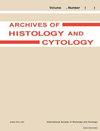Responses of infected dental pulp to αTCP-containing antimicrobials in rat molars
Q4 Medicine
引用次数: 5
Abstract
molar of 14-week-old rats and maintained without any treatment for 12 - 24 h. Subsequently, the exposed pulp was covered with α TCP or α TCP containing 3Mix, followed with glass ionomer cement. A pulp abscess lacking both dendritic cells and PGP 9.5-reactive nerve fibers was induced after pulp capping with α TCP; in contrast, numerous dendritic cells accumulated along the pulp-dentin border followed by the differentiation of odontoblast-like cells and matrix deposition after the application of α TCP containing 3Mix. PGP 9.5-reactive nerve fibers were also densely distributed and surrounded the accumulated dendritic cells in the medial dental pulp beneath α TCP containing 3Mix. The findings indicate that the application of α TCP containing 3Mix to the infected pulp induces an intense accumulation of dendritic cells, suggesting that these cells play crucial roles in the differentiation of odontoblast-like cells under pathological conditions. Summary. α -tricalcium phosphate ( α TCP) with the addition of antimicrobials such as ciprofloxacin, metronidazole, and cefaclor (3Mix) has been applied to sterilize the infected dentin and pulp in vivo . Both clinical and animal experiments have shown that 3Mix is effective for sterilizing infected tissues. However, the responses of the infected dental pulp to 3Mix remain to be fully determined at the cellular level. This study aims to clarify the responses of neural elements and immune cells to antimicrobials during the healing process of infected pulp using immunohistochemistry for protein gene product (PGP) 9.5 and class II major histocompatibility complex molecules using both light and electron microscopy. An artificial pulp exposure was prepared on the maxillary大鼠磨牙感染牙髓对含α tcp抗菌剂的反应
然后用α TCP或含3Mix的α TCP覆盖暴露的牙髓,再用玻璃离子水门合剂覆盖。α TCP盖髓后,树突状细胞和PGP 9.5反应性神经纤维均缺失,形成牙髓脓肿;与此相反,含有3Mix的α TCP在牙髓-牙本质边缘形成大量树突状细胞,形成成牙髓样细胞分化和基质沉积。在含有3Mix的α TCP下,PGP 9.5反应性神经纤维在牙髓内侧堆积的树突状细胞周围密集分布。结果表明,将含有3Mix的α TCP应用于感染牙髓可诱导树突状细胞大量聚集,提示树突状细胞在病理条件下对成牙髓样细胞的分化起着至关重要的作用。总结。采用α -磷酸三钙(α TCP)加环丙沙星、甲硝唑和头孢克洛(3Mix)等抗菌剂对感染牙本质和牙髓进行体内消毒。临床和动物实验都表明,3Mix对感染组织的消毒是有效的。然而,受感染的牙髓对3Mix的反应仍需在细胞水平上完全确定。本研究旨在利用光镜和电镜对蛋白基因产物(PGP) 9.5和II类主要组织相容性复合体分子进行免疫组化,阐明感染牙髓愈合过程中神经元件和免疫细胞对抗菌剂的反应。上颌预备人工牙髓外露
本文章由计算机程序翻译,如有差异,请以英文原文为准。
求助全文
约1分钟内获得全文
求助全文
来源期刊

Archives of histology and cytology
生物-细胞生物学
自引率
0.00%
发文量
0
期刊介绍:
The Archives of Histology and Cytology provides prompt publication in English of original works on the histology and histochemistry of man and animals. The articles published are in principle restricted to studies on vertebrates, but investigations using invertebrates may be accepted when the intention and results present issues of common interest to vertebrate researchers. Pathological studies may also be accepted, if the observations and interpretations are deemed to contribute toward increasing knowledge of the normal features of the cells or tissues concerned. This journal will also publish reviews offering evaluations and critical interpretations of recent studies and theories.
 求助内容:
求助内容: 应助结果提醒方式:
应助结果提醒方式:


